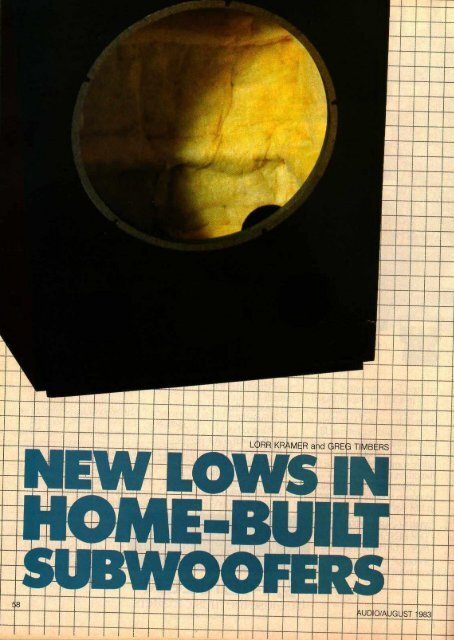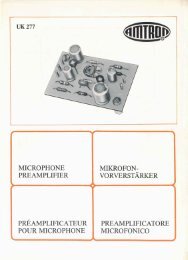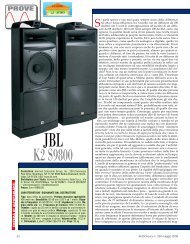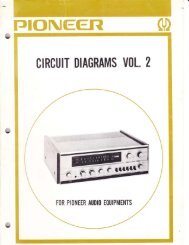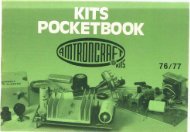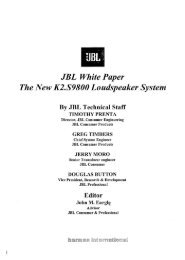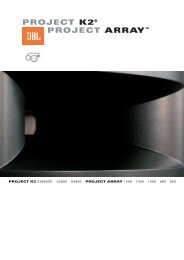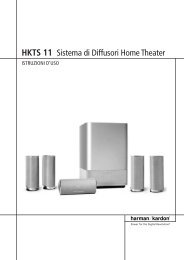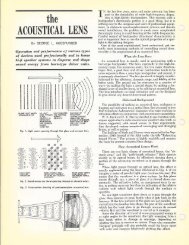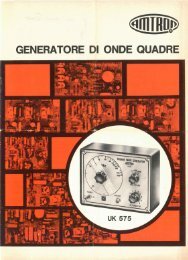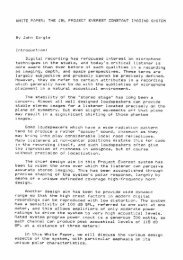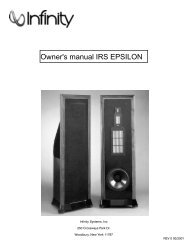JBL - New Lows in Home-Built Subwoofers (1983).pdf
JBL - New Lows in Home-Built Subwoofers (1983).pdf
JBL - New Lows in Home-Built Subwoofers (1983).pdf
You also want an ePaper? Increase the reach of your titles
YUMPU automatically turns print PDFs into web optimized ePapers that Google loves.
L(DRR KRAMER afiddREG TIMBERS I<br />
KUD O/AUGUST 983
A good subwooffpr<br />
mk freejstarjd<strong>in</strong>g, Ipw-f equency<br />
oudbpe^l^'sy^ernT^or sub,<br />
JIF^Woofer, s a proven n iethd)d oj<br />
en lane <strong>in</strong>g j>r, rr ore broperly, conjpletj<br />
_JDi a hign-quality, fullKanbe pudj<br />
spsakejr system Si npld <strong>in</strong> [concept!<br />
...the suDwaafer.dtoy.ittes an elbgarjt sol<br />
luton \o several acpusncal probjlem^<br />
-sip HJlta leously. jit is he-Qefr^Jt c^oie^ •<br />
for the jurist, and at the ?ame tim£ is i<br />
"soyrce of pla<strong>in</strong> nr<br />
This artic e prpvid ss tt e basic jnforj<br />
rm fiom necessary tor bi lildirjg ajvery<br />
hie h performance Bub\j/oofer. l(/1an\|<br />
ch )ice£ are possible albng the way<br />
some <br />
woofer's specialty really exisjt <strong>in</strong> rnos _<br />
record<strong>in</strong>gs? Sdmetrnesi yefc, some<br />
times nft Sitfficfj it to sayjhat (norf anc _<br />
mclre rfecorped jmatorial (<strong>in</strong>cludes sig-<br />
-f*tf leaf^Bfeffiroljien-f^ -an€ -<br />
thdtreiid is accelerat<strong>in</strong>g drarhatically.<br />
—Be<strong>in</strong>jrtfroTecjl thiifig, our spbwpofer<br />
is grossed cjiver SatJoW level a id dpverl<br />
byja sa5ar^te arSipifjer. II is p )ssiole fc"<br />
achieve this crossover at h gh_ jeye[ _<br />
bti the lardje <strong>in</strong>iductor rpqui edlbr a<br />
—low cr(j.sRo^er-.gQ<strong>in</strong>t [haajsigp ficacUoL<br />
sertion loss ancj adversely affects the<br />
dapipiijg of the drivyT^vl^^fnf^<br />
though youi wait to biamplijy for the<br />
tils. (In two-way systems, of aoursp,<br />
~tljre~cfr055pver is evenflTrg iBrf) ~Bap~<br />
ejxeurfeions modulate a wofer'ii mid-<br />
Jng^ouffiut; ipmdw<strong>in</strong>g fhe pwT ass (to<br />
e qubw oofeirs largely i olves tlie<br />
problem. Amplifiers, too, ike to me<br />
-BancUUmit 5d^<strong>in</strong>d-they^ like flflsa shqw<br />
their appreciation with (owe <strong>in</strong>termod-<br />
-tlation d<strong>in</strong>tortiDn, pic [not result is-acramatic<br />
impfovemenl <strong>in</strong> midrancie<br />
dlaciLy, SO StgiiifiCcail U|al njaiiyjlisl^iars<br />
consk er the idweripg or miaranAe<br />
IMTo Jbe the prima y bdnetij. | T<br />
1 There'slanqther nic4 bybrocftjct jpf<br />
t iamfblific itiori Su )pose ycjuVe nev&x<br />
-teen abh td decide, between thkt<br />
sweet-soi ndirig tube amp with tne<br />
--F msh/-ba iSrapd mat Jc|t&-olfeeAbaQkraolid-3tat€<br />
wotKhorpe yfflu bought a few<br />
"y ears bac cwhjch aountnsk<strong>in</strong>dI of harsh<br />
{<br />
J "^L£££_ *?L M<br />
1<br />
bpttom end. Far<br />
*c nee, you can Tiav J yoir cake ana eaT<br />
il too. 1 I I<br />
There's moie. The fcalarlice pf lew<br />
_t ass, xela ive th thaxesj of tliie f reque i=_<br />
cy spectrjm, varies vyidell from re-<br />
~e efdira-t€ -feeeFdtffeH-^iQ'p pastly-be—<br />
daus4 of he I mitations of ^ome loup-<br />
~skjeakeis jswd <strong>in</strong>dpprobndtfelycjs coiitroi-rpom<br />
mopitoi|s. $r\d [witq yojjr<br />
~aIBwp6Te 7~yoLi'll Detter <strong>in</strong>tormea.)<br />
Qompens &\or\ with tope controls br<br />
aquaizers isnt satsfyiijig because, Ipy<br />
.def<strong>in</strong>itiopi they .a e. rflr£l\| nepterffiri<br />
where you need (rem and also be-<br />
Ouhe audio (^a<strong>in</strong>fWraiap^<br />
•~ypa-c arrTise-Artower the bass ampli fr=ar<br />
level wi:houj affect<strong>in</strong>g thq res^ of the<br />
$y$fe\TTT iis*ii particularly convenient<br />
when the biamp crossover [has an \JF<br />
ga<strong>in</strong> iontr DI <strong>in</strong>jeasy rea :h. iji oui exps-<br />
-jjeneffi,. whLlft A "hf^t o> erall" se z<br />
trig is quickly [established<br />
-feMhe ^jofity-o^-program—<br />
matenial, other? rec6rdiijigs<br />
ciyt 3H0 -a<br />
rjudgemcre or less<br />
!Sw"Bass7 and tfiis"<br />
flexib lity i > really _<br />
"Handy.<br />
'<br />
frequency responsy<br />
exjtei^dipg pe^owj the |<br />
' lowest notes foundj on<br />
to the fun. Here are j<br />
se #ejal pTa nsi 01 iie" oTT j<br />
Lor^ Kratner fs Pfodu&t M<strong>in</strong>ag ?rr<br />
Conpurrrpr Pi\odufts cjf JB\.<br />
Incorporated Nonhnqge, La/.<br />
Greh Tirhberh<br />
Transducer<br />
is i/BL'k Senior<br />
Eng<strong>in</strong>eer!<br />
br<strong>in</strong>gs. Rerpemper (hat [he yrosfovej<br />
from trie WooTer to I the midrangp, ir~<br />
most tftree-Uay loudspeaker systems _<br />
f<br />
occurs above mbst musical fundamen i-Tffe <strong>JBL</strong><br />
ejL2245H;18-ifichl<br />
AUDIO/AUGUST 1988 frequency transducer] 1<br />
59
—It you ownJstock irV the jumbe r<br />
i n d ust ry ai Fid-lray cha-ciir eot-iiit k -to<br />
Hoover Dam, you migh^wa^t* *t<br />
Computergenerated<br />
table<br />
of the project<br />
subwoofer s<br />
performance<br />
limits.<br />
* 8 CU FT SUEHOOFER USING JE4. 2?«t5H *<br />
*ttK*trx*nxxxn*K*im* Kdvfjt PARAMETERS xnntfnuiu<strong>in</strong>nusuiuBUui<br />
FKI:E-AXR RESONANCE FREQUENCY « 20.0 HZ<br />
cown.tft.Ncir EQUIVALENT VOL. - 29.000 cu FT<br />
0 SUB TS • 0.270<br />
EFFICIENCY
safe excursion limit of 1 <strong>in</strong>ch, peak-topeak.<br />
Extended bass at reasonable efficiency<br />
requires either very large box<br />
volume, or large amounts of amplifier<br />
horsepower—or both. We sat down<br />
with our friendly vented-box design<strong>in</strong>g<br />
computer and came away with two <strong>in</strong>terest<strong>in</strong>g<br />
candidates. The first is a 12-<br />
cubic-foot box tuned to 20 Hz. This is a<br />
classic sixth-order alignment requir<strong>in</strong>g<br />
6 dB of boost at 20 Hz and result<strong>in</strong>g <strong>in</strong><br />
a system f 3 (3 dB-down po<strong>in</strong>t) of about<br />
21 Hz. The second contestant is an 8-<br />
cubic-foot box, quasi-third-order alignment,<br />
tuned to 26 Hz. With 6 dB of<br />
boost added at 26 Hz, it becomes a<br />
quasi-fifth-order system with an f 3 of 26<br />
Hz. For this project, we chose the latter<br />
system because of its more moderate<br />
size. The 26-Hz cutoff was deemed low<br />
enough not to compromise sonic performance.<br />
Fig. 4—The <strong>JBL</strong><br />
Model BX63<br />
divid<strong>in</strong>g/summ<strong>in</strong>g network.<br />
PS- 2B.0 HZ VAS- 821.2 LITERS, 29.BO CU FT OTS- 0.270<br />
VB LITERS - 226.5 CU FT e.00 FB HZ 26.0<br />
Our computer provided a table, <strong>in</strong>cluded<br />
here, list<strong>in</strong>g driver parameters<br />
and response of the 2245H, and maximum<br />
output with respect to thermal<br />
and displacement limits when <strong>in</strong>stalled<br />
<strong>in</strong> the project box. Note the extremely<br />
high output levels. This system is the<br />
acoustical equivalent of the <strong>JBL</strong> Model<br />
B460 low-frequency loudspeaker.<br />
You might now ask, "Why equalize?"<br />
In order to keep the efficiency up and<br />
the box size down, we chose to take<br />
advantage of the driver's sizable power<br />
capacity and the relatively <strong>in</strong>expensive<br />
price of amplifier power. Notice<br />
that the system has an unequalized f 3<br />
of about 35 Hz, which means that the<br />
extra power demands of the boost only<br />
come <strong>in</strong>to play when there is substantial<br />
signal below 35 Hz.<br />
The equalization necessary to flatten<br />
the response is shown <strong>in</strong> Fig. 2. The<br />
2245H can be crossed over as high as<br />
500 Hz, because its midrange response<br />
is smooth. A number of lowlevel<br />
crossovers suitable for subwoofers<br />
are commercially available.<br />
Figure 3 shows the voltage drive of our<br />
recommended crossover, the <strong>JBL</strong><br />
Model BX63 (Fig. 4), which was chosen<br />
for this application because it was<br />
designed specifically for the present<br />
comb<strong>in</strong>ation of driver and enclosure.<br />
[Editor's Note: Plans for a crossover<br />
you can build yourself are elsewhere <strong>in</strong><br />
this issue.] Figure 5 illustrates the comb<strong>in</strong>ed<br />
subwoofer and crossover response<br />
with 3 dB-down po<strong>in</strong>ts of 26<br />
Fig. 5— Response of BX63 network<br />
(top curve) and driver's unassisted<br />
output (bottom curve) comb<strong>in</strong>e<br />
(middle curve) to produce flatter<br />
response down to 26 Hz and<br />
Fig. 6—Power compression of<br />
project subwoofer. Note lack of<br />
compression at levels below<br />
10 watts, slight compression above.<br />
greater output above 20 Hz than<br />
unassisted driver. Data above<br />
diagram are driver parameters for<br />
free-air resonance, compliance<br />
equivalent volume, and total "Q."<br />
Fig. 7— Distortion at 100 dB<br />
drive level. Levels shown for<br />
second- and third-harmonic<br />
products have been shifted up by<br />
20 dB to fit chart recorder.<br />
AUDIO/AUGUST <strong>1983</strong> 61
Fig. 8—The 8-cubic-foot<br />
project subwoofer with<br />
18-<strong>in</strong>ch driver.<br />
and 63 Hz. The quasi-fifth-order alignment<br />
<strong>in</strong>cludes a subsonic roll-off to unwanted<br />
cone motion below 20 Hz.<br />
The performance of the project box<br />
is summarized <strong>in</strong> Figs. 6 and 7. Figure<br />
6 illustrates power compression. Note<br />
zero compression as <strong>in</strong>put rises 10 dB<br />
from 1 to 10 watts; output tracks with<br />
the same 10 dB rise. Over the next 10<br />
dB, from 10 to 100 watts, only 1 to 2 dB<br />
of compression occurs; most loudspeakers<br />
would never even reach this<br />
output level. Figure 7 shows secondand<br />
third-harmonic distortion at the<br />
100 dB drive level; -40 dB represents<br />
1% distortion. At this output level, distortion<br />
of less than 5% to 10% is very<br />
unusual, regardless of loudspeaker<br />
type.<br />
Fig. 9—Construction sketch lor<br />
8-cubic-foot enclosure. Dimensions<br />
shown are <strong>in</strong>side dimensions.<br />
Braces, cleats and port duct are<br />
1<br />
shown as dotted l<strong>in</strong>es.<br />
Construction<br />
We have built several different enclosure<br />
shapes for various visual considerations,<br />
with no problems acoustically.<br />
It is always wise to avofd <strong>in</strong>terior<br />
dimensions whose ratios are 2:1, 3:1,<br />
4:1, etc., because such <strong>in</strong>tegral ratios<br />
often promote severe stand<strong>in</strong>g wave<br />
problems. For the same reason, it<br />
helps to mount the driver approximately<br />
one-third of the way down the long<br />
side. Our project enclosure (Fig. 8) has<br />
<strong>in</strong>ternal dimensions of 31 x 23'/2 x 19<br />
<strong>in</strong>ches. Refer to Fig. 9 for construction<br />
details. We recommend 1-<strong>in</strong>ch particleboard<br />
or fiberboard, 50-pound density<br />
or greater, for the requisite acoustical<br />
deadness. Plywood is acceptable,<br />
but generally not as dense as composition<br />
materials. The panels should be<br />
further stiffened by 2 x 4s run the long<br />
dimension on each side, top and bottom.<br />
These stiffeners should be offset<br />
from the panel centers slightly so that<br />
they overlap <strong>in</strong> the corners and can be<br />
glued together. A back brace runs<br />
from top to bottom and should be cut<br />
so that it just touches the top and bottom<br />
panels. A baffle stiffener, which<br />
should be kept clear of the side panels<br />
so that it doesn't buzz, is also used. All<br />
stiffeners should be securely glued to<br />
the panels with your favorite brand of<br />
white glue. The type of jo<strong>in</strong>ery used<br />
between panels will depend on your<br />
expertise and on the type of f<strong>in</strong>ish details<br />
you desire; simple butt jo<strong>in</strong>ts us<strong>in</strong>g<br />
plenty of glue and an occasional glue<br />
block are completely acceptable for<br />
strength.<br />
62 AUDIO/AUGUST <strong>1983</strong>
"We chose a vented box for its very low —<br />
Hictnvt<strong>in</strong>n avfanrlaflJfMLUoniianAii m i i A l i<br />
~ and significantly better dynamic<br />
performance."<br />
The baffle can be permanently attached<br />
(glued <strong>in</strong> place) or removable<br />
(us<strong>in</strong>g screws and cleats). If it is to be<br />
removable, use caulk<strong>in</strong>g to make certa<strong>in</strong><br />
there are no air leaks. The box<br />
should be l<strong>in</strong>ed with fiberglass on the<br />
back, sides, top, and bottom. House<br />
<strong>in</strong>sulation glass is f<strong>in</strong>e; if it is foilbacked,<br />
be sure to place the foil side<br />
aga<strong>in</strong>st the cab<strong>in</strong>et. The port area<br />
should be 27 square <strong>in</strong>ches, and the<br />
duct length (<strong>in</strong>clud<strong>in</strong>g baffle thickness)<br />
should be 12 <strong>in</strong>ches. We typically use<br />
thick-walled cardboard tubes for our<br />
ducts. PVC pipe also works well, as do<br />
rectangular ducts fabricated from VA<strong>in</strong>ch<br />
masonite or 3 /a-<strong>in</strong>ch particleboard.<br />
(For a 27-square-<strong>in</strong>ch area, a round<br />
tube's <strong>in</strong>ternal diameter should be 5.86<br />
<strong>in</strong>ches.) Remember that as long as the<br />
port area is ma<strong>in</strong>ta<strong>in</strong>ed, the cross-sectional<br />
shape (round, square, etc.) is not<br />
important.<br />
The enclosure proportions are<br />
equally suited to lowboy or highboy<br />
orientation. We advise you to f<strong>in</strong>ish all<br />
four sides so that you always have the<br />
choice. A non-attached kick base,<br />
about Vh <strong>in</strong>ches high, can now be<br />
fabricated so that the system will appear<br />
to hover above the floor. This<br />
treatment makes the cab<strong>in</strong>et appear<br />
more f<strong>in</strong>ished and less bulky. If you<br />
wish to build a grille, allow at least 1<br />
<strong>in</strong>ch clearance <strong>in</strong> front of the baffle for<br />
the 2245H frame thickness and forward<br />
suspension travel. Use an openweave<br />
cloth, and stretch it tightly so<br />
that it doesn't flap. Too tight a weave<br />
will tend to damp port operation,<br />
Considerable current will be flow<strong>in</strong>g<br />
to the subwoofer at times, so use, at<br />
the very least, 16-gauge stranded wire<br />
or a high-quality loudspeaker cable for<br />
your <strong>in</strong>ternal connections. Use a good<br />
<strong>in</strong>put connector such as a five-way<br />
b<strong>in</strong>d<strong>in</strong>g post, and solder the <strong>in</strong>ternal<br />
wire to the back of the term<strong>in</strong>al. Your<br />
external wire run should be as short as<br />
possible; use premium cable.<br />
Alternative Designs<br />
Some of you might be <strong>in</strong>terested <strong>in</strong><br />
the 12-cubic-foot box mentioned earlier;<br />
Fig. 10 gives the necessary construction<br />
details. Two systems are possible.<br />
The first is a 25-Hz, unassisted<br />
fourth-order alignment. The second is<br />
a 20-Hz, sixth-order assisted (EQ-required)<br />
alignment. The 12-cubic-foot<br />
441 mm<br />
17-3/8"<br />
BELT CIRCLE<br />
DIAMETER<br />
60 mm.<br />
2-3/8"N<br />
MA 15 CLAMPS<br />
(8 PLACES)<br />
427 mm<br />
16-13/16'<br />
DIAMETER<br />
53 mm<br />
2-3/32><br />
225 mm<br />
DIAMETER<br />
Ill7mm<br />
Fig. 10—Plans for a 12-cubic-foot<br />
subwoofer enclosure. Exterior<br />
dimensions shown produce correct<br />
<strong>in</strong>terior volume when 3 /4-<strong>in</strong>ch board<br />
is used for walls; for thicker walls,<br />
<strong>in</strong>crease exterior dimensions<br />
accord<strong>in</strong>gly. Internal brac<strong>in</strong>g has<br />
been omitted from diagram for<br />
clarity (see text). All sides except<br />
the baffle panel are to be with<br />
1 to 2 <strong>in</strong>ch (25 to 50 mm)<br />
fiberglass. For the 25-Hz.<br />
unassisted fourth-order alignment,<br />
duct length should be 20 <strong>in</strong>ches<br />
(508 mm), and a 15 to 20 Hz<br />
high-pass filter is strongly<br />
recommended. For the 20-Hz, sixthorder<br />
alignment, duct length is<br />
30 <strong>in</strong>ches (762 mm), and a low-level<br />
unassisted design gives essentially the<br />
same response curve as our 8-cubicfoot<br />
project box, and does so without<br />
the 6 dB of equalization. Aga<strong>in</strong>, the<br />
trade-off is enclosure volume versus<br />
amplifier power.<br />
If you own stock <strong>in</strong> the lumber <strong>in</strong>dustry<br />
and have a direct l<strong>in</strong>k to Hoover<br />
737 mm<br />
29".<br />
DUCT SCREWED INTO<br />
BOTTOM AND SIDE<br />
OF ENCLOSURE<br />
533mm<br />
equalizer with +6 dB boost at<br />
20 Hz and Q = 2 is required. It is<br />
recommended that this unit be<br />
used only below 80 Hz, with a<br />
monaural bass sum signal.<br />
Dam too, then you can build the 12-<br />
cubic-foot, 20-Hz enclosure. It requires<br />
6 dB of boost at 20 Hz, <strong>in</strong> addition to<br />
be<strong>in</strong>g huge, but will return a 3 dBdown<br />
po<strong>in</strong>t slightly above 20 Hz. We<br />
consider this box to be an <strong>in</strong>terest<strong>in</strong>g<br />
exercise, but overkill for almost all program<br />
material.<br />
AUDIO/AUGUST <strong>1983</strong> 63
For the rest of you who consider 12<br />
cubic feet way too large and 8 cubic<br />
feet a little too large, we have a 4V2-<br />
cubic-foot offer<strong>in</strong>g <strong>in</strong>tended for use<br />
with the <strong>JBL</strong> Model 2235H 15-<strong>in</strong>ch<br />
driver. This subwoofer gives essentially<br />
the same curve shape as the 8-<br />
cubic-foot box, requires the same<br />
equalization, and is 4 dB less efficient.<br />
The 2235H handles a little less power,<br />
so this system has a 6 dB lower overall<br />
output capability (still very substantial,<br />
however). All of the construction details<br />
are the same as for the 8-cubicfoot<br />
project box, except that this enclosure<br />
was designed with %-<strong>in</strong>ch material.<br />
The exterior dimensions are 27Vz x<br />
20% x 17 <strong>in</strong>ches. The port area<br />
should be 13V2 square <strong>in</strong>ches, and the<br />
duct 12 <strong>in</strong>ches long (<strong>in</strong>clud<strong>in</strong>g the baffle<br />
thickness). For the smaller panel<br />
sizes of this enclosure, 1 x 3-<strong>in</strong>ch<br />
braces are sufficient. This system is<br />
equivalent <strong>in</strong> dimensions and performance<br />
to the <strong>JBL</strong> Model B380 subwoofer<br />
(Fig. 11).<br />
Fig. 11—The <strong>JBL</strong> B380,<br />
a 4V2-cubic-foot<br />
subwoofer, us<strong>in</strong>g a<br />
15-<strong>in</strong>ch driver.<br />
Power Considerations<br />
To provide adequate headroom, no<br />
less than 200 watts should be used<br />
with any of the subwoofers described.<br />
Significantly better dynamic performance<br />
can be achieved with larger<br />
amplifiers— assum<strong>in</strong>g, of course, that<br />
the ma<strong>in</strong> loudspeakers and amplifiers<br />
can keep up. A mean<strong>in</strong>gful maximum<br />
power limit is difficult to set because of<br />
the dynamic nature of music. The cont<strong>in</strong>uous<br />
s<strong>in</strong>e wave power rat<strong>in</strong>gs of the<br />
2245H and 2235H drivers are 300 and<br />
150 watts, respectively. With music as<br />
a signal and with the drivers loaded<br />
<strong>in</strong>to their enclosures, nom<strong>in</strong>al maximum<br />
amplifier power guidel<strong>in</strong>es of 800<br />
and 600 watts, respectively, apply. But<br />
if you are will<strong>in</strong>g to travel at your own<br />
risk, we'll reveal that, <strong>in</strong> our experience,<br />
the bigger the amp, the better. In<br />
our listen<strong>in</strong>g room, which is rather<br />
large and acoustically dead, our 18-<br />
<strong>in</strong>ch, 8-cubic-foot subwoofer is connected<br />
to 2 kilowatts of power and has<br />
never shown any sign of distress even<br />
at peak amplifier output. In short, <strong>in</strong><br />
most cases the bass amplifier will<br />
reach its limit before these subwoofers<br />
will reach theirs.<br />
If you are us<strong>in</strong>g a s<strong>in</strong>gle subwoofer<br />
and don't have a s<strong>in</strong>gle-channel amplifier<br />
handy, a convenient way to get the<br />
power is to bridge a dual-channel amplifier.<br />
Depend<strong>in</strong>g on its power supply<br />
and current capability, a bridged amplifier<br />
can produce up to four times its<br />
per-channel rat<strong>in</strong>g. Most bass is transient<br />
<strong>in</strong> nature, so unless it's a susta<strong>in</strong>ed<br />
organ pedal or synthesizer, you<br />
will be able to get peaks of nearly fourtimes<br />
rated power even out of less robust<br />
amplifier designs. Of further comfort<br />
to the bass amplifier is the fact that,<br />
with the project subwoofer, maximum<br />
EQ boost occurs at vent resonance,<br />
present<strong>in</strong>g close to a purely resistive<br />
load to the amplifier at that po<strong>in</strong>t.<br />
Some amplifiers bridge at the flip of<br />
a switch; at the opposite extreme, non<strong>in</strong>vert<strong>in</strong>g<br />
designs with no bridg<strong>in</strong>g provision<br />
require that the <strong>in</strong>put to one<br />
channel be <strong>in</strong>verted by additional circuitry.<br />
The BX63 network mentioned<br />
above <strong>in</strong>cludes both normal and <strong>in</strong>verted<br />
LF outputs, which will quickly<br />
bridge the vast majority of dual-channel<br />
amps available.<br />
Sett<strong>in</strong>g Up<br />
The optimum placement for a subwoofer<br />
is generally between the fullrange<br />
systems, and with<strong>in</strong> 3 feet of a<br />
l<strong>in</strong>e drawn between them (3 feet forward<br />
to 3 feet beh<strong>in</strong>d the l<strong>in</strong>e). Proper<br />
polarity is, of course, critical, and with<br />
all the <strong>in</strong>versions possible <strong>in</strong> the cha<strong>in</strong><br />
(especially with a bridged amplifier),<br />
the best way to check phase is by ear.<br />
Repetitive, percussive bass, such as<br />
kick drum or bass guitar, is the material<br />
easiest to use for this purpose. To<br />
the extent that your room allows, experiment<br />
with placement us<strong>in</strong>g record<strong>in</strong>gs<br />
with deep bass content. Shifts <strong>in</strong><br />
location of 6 <strong>in</strong>ches can have a perceptible<br />
effect.<br />
As a start<strong>in</strong>g po<strong>in</strong>t for sett<strong>in</strong>g level,<br />
the bass ga<strong>in</strong> should be advanced just<br />
to the threshold where sound above<br />
the crossover po<strong>in</strong>t beg<strong>in</strong>s to be affected<br />
by switch<strong>in</strong>g the subwoofer <strong>in</strong> and<br />
out. In any case, it won't take much<br />
listen<strong>in</strong>g to f<strong>in</strong>d the right sett<strong>in</strong>g subjectively.<br />
Typically, subwoofers are set<br />
highest when first <strong>in</strong>stalled, out of the<br />
owner's enthusiasm for his new toy. If<br />
the owner is also the builder, his enthusiasm<br />
can be described as maximal.<br />
After the <strong>in</strong>titial fun, the listener usually<br />
f<strong>in</strong>ds that sett<strong>in</strong>g most satisfy<strong>in</strong>g which<br />
provides the most realism—<strong>in</strong> other<br />
words, real life rather than larger than<br />
life. And once you've experienced a<br />
good subwoofer, properly set up, noth<strong>in</strong>g<br />
short of that performance level<br />
sounds like real life.<br />
&<br />
Acknowledgements<br />
The authors would like to thank W. J.<br />
J. Hoge of <strong>JBL</strong> for sett<strong>in</strong>g the stage<br />
with his very popular subwoofer article<br />
of 1976 <strong>in</strong> these pages. His work made<br />
our efforts quite straightforward. We<br />
would also like to thank D. B. Keele, Jr.<br />
(<strong>JBL</strong>) for his k<strong>in</strong>d assistance with the<br />
computer. His efforts made the special<br />
voltage drive of the BX63 a reality. F<strong>in</strong>ally,<br />
we would like to credit Douglas<br />
Warner of Warner Design, Berkeley,<br />
Cal. for the proportions of the 8- and 5-<br />
cubic-foot enclosures (and the <strong>in</strong>dustrial<br />
design of the 2245H, BX63, B460.<br />
and B380).<br />
References<br />
Hoge, W. J. J., "Switched On Bass,"<br />
Audio, Aug. 1976 ("Addenda,'' Nov.<br />
1976, pg. 24); "Confessions of a<br />
Loudspeaker Eng<strong>in</strong>eer," Audio, Aug.<br />
1978.<br />
Keele, D. B., Jr., "Low-Frequency<br />
Loudspeaker Assessment by Nearfield<br />
Sound-Pressure Measurement,"<br />
Journal of the Audio Eng<strong>in</strong>eer<strong>in</strong>g<br />
Society, April 1974; "A <strong>New</strong><br />
Set of Sixth-Order Vented-Box Loudspeaker<br />
System Alignments," JAES,<br />
June 1975; "Direct Low-Frequency<br />
Driver Synthesis from Systems<br />
Specifications," JAES, Nov. 1982.<br />
Small, R. H., "Vented-Box Loudspeaker<br />
Systems, Part III: Synthesis, JAES,<br />
Sept. 1973.<br />
64 AUDIO/AUGUST <strong>1983</strong>


